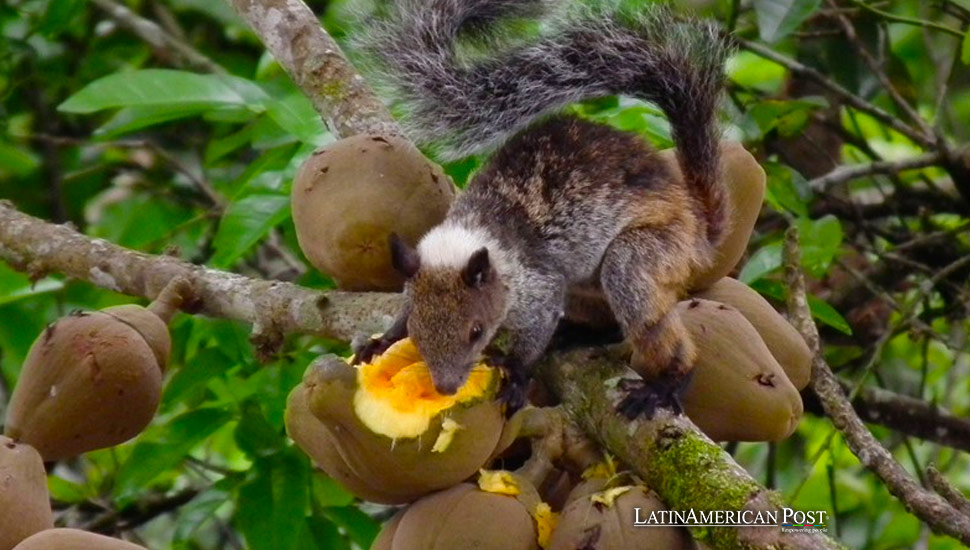Black-Coated Squirrels Discovered in Ecuador’s Andean Regions

Researchers have detected the first melanism cases in the Ecuadorian Andes white-naped squirrels. This discovery marks a significant departure from their usual coloration and underscores the importance of biodiversity and conservation in Latin America.
A group of researchers, in collaboration with the National Institute of Biodiversity (Inabio) of Ecuador and the Nature and Culture Foundation, has detected the first cases of melanism (black fur) in the white-naped squirrels (Simosciurus nebouxii). These species inhabit the Andes of southern Ecuador and northern Peru, traditionally representing gray, yellow, and reddish colors. This finding marks a groundbreaking development in studying this species.
Eighteen black-furred specimens were found in the southern Andean province of Loja, Ecuador, which borders Peru. According to a statement released by Inabio on Monday, these squirrels were identified as having an excess of melanin, resulting in their unique coloration. Of these eighteen cases, six were recorded in the La Ceiba Natural Reserve and five in its buffer zone, encompassing the localities of Limones, Garza Real, and Paletillas.
Two more specimens were reported in the Private Protected Area of Cazaderos, within the locality of Cazaderos. Additionally, two were found in the Municipal Ecological Conservation Area of Los Guayacanes, and three individuals, two paired and one solitary, were spotted in the locality of Mangahurco.
Characteristics of the White-Naped Squirrel
The primary characteristic of this squirrel is a white to grayish patch on the back of its neck. Typically, their limbs are dark, their bellies are yellow mixed with gray, their backs range from yellowish-gray to reddish-brown, and their tails are dark to gray with a yellowish base. However, the squirrels in this research exhibited dark fur across their entire bodies, except for the nape and part of the tail, interspersed with white hairs.
These individuals could be differentiated by the varying patterns of white spots on the nape patch and in other areas dispersed towards the back. The researchers, Daniel Sanmartín, Stefany Vega, Jorge Patiño, Guilbert Olaya, Felipe Sánchez, and Jorge Brito, pointed out that melanism is a condition defined by the darkening of the organism’s surface pigment due to significant melanin production.
Significance of Fur Coloration in Animals
Fur coloration in animals serves different functions associated mainly with thermoregulation, inter and intraspecific communication, sensory perception, and the regulation of physiological processes. Habitat conditions play an essential role in the appearance of individuals with atypical colorations. These changes can result from the expression of recessive alleles and are more pronounced in small and isolated populations. If this coloration benefits the species’ fitness, it could become fixed in the population through Darwinian selection.
Melanism is widespread among mammal species, leading researchers to hypothesize about its adaptive benefits in specific environments. Inabio noted that cases of melanism in mammals globally had been recorded in at least a hundred species, six of which are found in Ecuador: the rodents ‘neomicroxus latebricola’ and ‘echimys saturnus,’ the jaguar (Panthera onca), the anteater (Tamandua tetradactyla), the ocelot (Leopardus tigrinus), and now the white-naped squirrel (Simosciurus nebouxii).
Latin American Context and Conservation Implications
In the broader Latin American context, the discovery of melanism in the white-naped squirrel highlights the region’s rich biodiversity and the importance of conserving its unique habitats. Latin America is home to an extensive range of ecosystems, from the Amazon rainforest to the Andean mountains, hosting many species with diverse genetic traits and adaptations.
The occurrence of melanism in these squirrels not only adds to the understanding of the species’ genetic diversity but also underscores the need for continued conservation efforts. The Andes, in particular, are a critical region for biodiversity, providing habitat for numerous endemic species. Protecting these environments ensures the survival of unique genetic variations like melanism, which can offer insights into evolutionary processes and environmental adaptations. This discovery further highlights the importance of preserving these unique habitats and the species that depend on them.
Detecting black-coated white-naped squirrels in the Andes of Ecuador represents a significant scientific finding. The condition of melanism, marked by an excess of melanin leading to black fur, adds to the complexity of this species’ genetic makeup. As researchers continue to study these unique specimens, the role of habitat conditions and genetic diversity in shaping such traits becomes increasingly apparent. This discovery opens up new avenues for research and underscores the importance of genetic diversity in conservation efforts.
Also read: Ecuador’s Biodiversity Efforts Bolstered by New Biobank Network
This discovery also serves as a powerful reminder of the audience’s role in conserving the rich biodiversity of Latin America. By actively participating in the protection of the diverse habitats of the Andes and beyond, we can ensure the survival of the species that inhabit these regions and the genetic variations that contribute to their adaptability and survival. In doing so, we ensure that future generations can continue to learn from and benefit from the natural wonders of our world.




